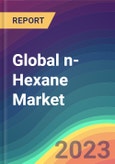n-hexane is a volatile aliphatic hydrocarbon that can be synthesized using both natural gas and crude oil using the fractional distillation process. By using specific catalysts, it can also be produced from sugar cane waste. For a variety of seed crops, including soybeans, cottonseed, rape seed, mustard seed, peanuts, flax (linseed), safflower seed, and corn germ, n-hexane is primarily utilized as an edible-oil extractant. These seed crops are further processed into foods for humans and animals. Other significant applications for n-Hexane as a special-purpose solvent and cleaning agent (degreaser) include the production of textiles, footwear, leather, and furniture. n-hexane may be present in a variety of glues, adhesives, and leather-dressing preparations, particularly those used in the manufacturing of shoes. In addition, the pharmaceutical sector is one of the biggest consumers of n-hexane due to its use in numerous syntheses and separations, as well as the shape of pills and tablets.
During the course of the projection period, n-high Hexane's demand from the food industry is anticipated to fuel market expansion. Because it provides excellent yield from a variety of seeds, n-hexane is frequently employed as an extraction agent for edible oils. This is anticipated to result in significant demand from the food industry for n-Hexane. Furthermore, the application of n-Hexane for manufacturing adhesives and sealants which have applications in various industries also contributes to the n-Hexane market expansion. The size of the global n-Hexane market in terms of volume is estimated to reach nearly 1800 thousand tonnes by 2032.
Based on region, Asia Pacific is dominating the global n-Hexane market, followed by Europe. In 2022, Asia Pacific held a market share of more than 50% of the global n-Hexane. Accelerating demand for refined oil for cooking purposes in developing countries like India and China is majorly contributing to the n-Hexane market. In terms of production, the Asia Pacific region is again dominating the global n-Hexane market.
Based on the end-user industry, the global n-Hexane market is segmented into Edible Oil Extractant, Adhesives & Sealants, Paints & Coatings, Industrial Solvent, and Others. Among these, the Edible Oil Extractant sector is in the lead and held approximately 45% of the market share in 2022. Additionally, the Adhesives & Sealants sector is also a prominent consumer of the n-Hexane market.
Major players in the production of Global n-Hexane are KazmunayGas International, ExxonMobil Chemical, Indian Oil Corporation Limited, Chennai Petroleum Corporation Limited, Jun Yuan Petroleum Group, Bharat Petroleum Corporation Limited, and Others.
Years considered for this report:
- Historical Period: 2015- 2022
- Base Year: 2022
- Estimated Year: 2023
- Forecast Period: 2024-2032
Objective of the Study:
- To assess the demand-supply scenario of n-Hexane which covers production, demand and supply of n-Hexane market in the globe.
- To analyse and forecast the market size of n-Hexane
- To classify and forecast Global n-Hexane market based on end-use and regional distribution.
- To examine competitive developments such as expansions, mergers & acquisitions, etc., of n-Hexane market in the globe.
The publisher calculated n-Hexane demand in the globe by analyzing the historical data and demand forecast which was carried out considering the production of raw material to produce n-Hexane. The publisher sourced these values from industry experts and company representatives and externally validated through analyzing historical sales data of respective manufacturers to arrive at the overall market size. Various secondary sources such as company websites, association reports, annual reports, etc., were also studied by the publisher.
Key Target Audience:
- n-Hexane manufacturers and other stakeholders
- Organizations, forums and alliances related to n-Hexane distribution
- Government bodies such as regulating authorities and policy makers
- Market research organizations and consulting companies
Report Scope:
In this report, Global n-Hexane market has been segmented into following categories, in addition to the industry trends which have also been detailed below:- Market, by End-use: Edible Oil Extractant, Adhesives & Sealants, Paints & Coatings, Industrial Solvent, and Others
- Market, by Sales Channel: Direct Sale and Indirect Sale
- Market, by Region: North America, Europe, Asia Pacific, Middle East and Africa, and South America.








